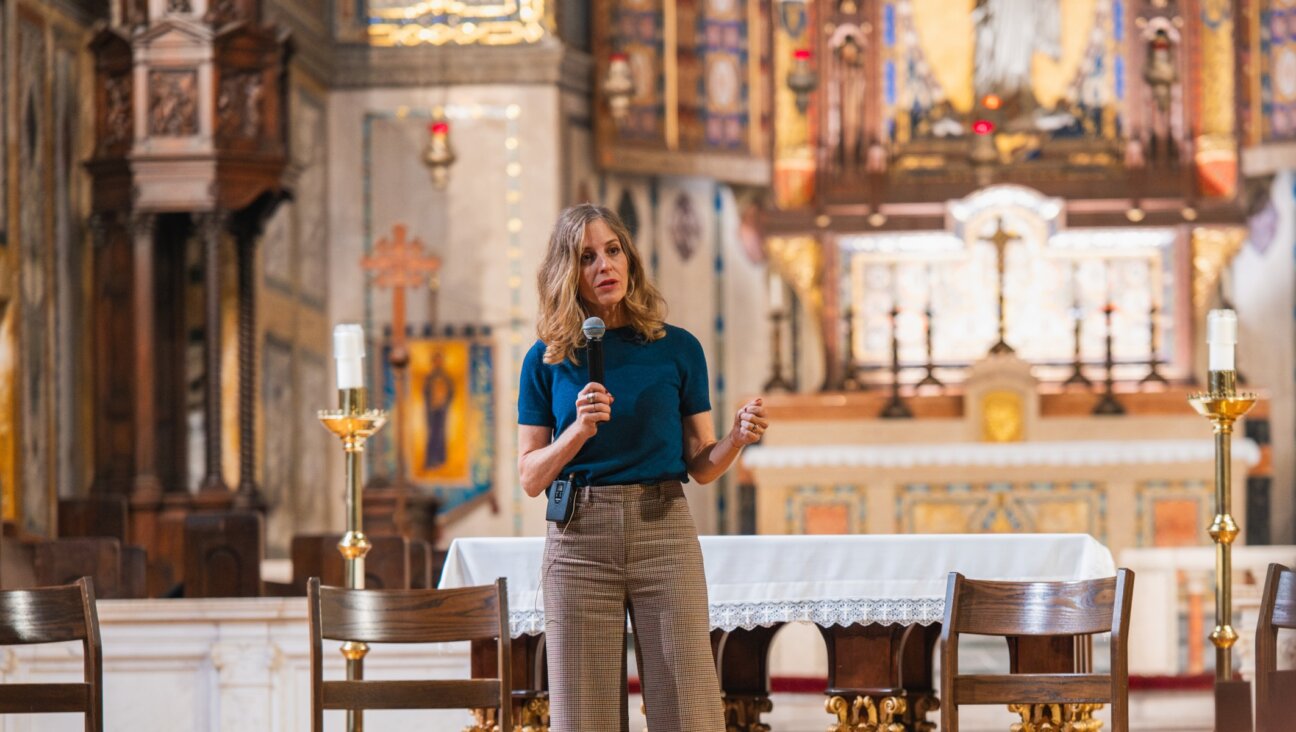Spousal Lectures, Schnapps and Other Glories Celebrated by Unlikely Klezmorim Group
It was nearly 8 p.m. when the klezmorim danced their way in to greet the crowd, hoisted their instruments on stage and proceeded to make a l’chaim on the berry-flavored schnapps that awaited them in a tall, elegant bottle. The musicians didn’t look like Old World incarnates in their sleek black ensembles, nor did they sound like street entertainers when they commenced their lecture on Eastern European “musical ambiences,” but when they began to sing one understood that their sound was as authentic as their centuries-gone counterparts.
The Singing Table, featuring Michael Alpert, Sruli Dresdner and Lisa Mayer, which appeared at the Graduate Center of the City University of New York last month and will perform March 26 at the Neo-Hasidic Conference at the Jewish Community Center in Manhattan, is an unusual pairing of play and academe: The three musicians alternately hummed tunes and recounted history, sounding both melodically plaintive in their songs and authoritatively wistful in their discourse. Indeed, the trio is a remarkably fluid mix of personalities: Alpert accompanies his historical explanations with slow, mournful accordion chords; clarinetist Dresdner intones mystical nigunim as if in a trance — like his own chasidic ancestors, he tells us — and Mayer, the violinist, both jokes and bows with virtuosic pluck and a winsome smile.
Sometimes, the nigunim reflect the sadness and weight of history; other times, they bespeak joy and transcendence. One song that many audience-members recognized, whose lyrics comprised an acrostic, served to teach children a life-lesson along with the aleph-bet. “AZ Nisht Kein Emunah” it was called, and its message is relevant to today’s success-driven kinder — one of its lines reads in translation: “If you have no rachmones, for what are you ripping this world apart?”
In introducing these songs, the musicians were careful to pay homage to the family members that, in many cases, resurrected the tunes from historical oblivion. One melody, with a joyful refrain that the audience picked up immediately, was sung to the Satmar rebbe upon his postwar arrival in America. To this day, Dresdner told the audience, his father remembers the rebbe’s appearance in Williamsburg, Brooklyn. Dresdner has an uncle who is equally proud of his chasidic heritage and has taught his nephew many nigunim. This uncle, Mayer quipped, is still single, takke, and wants to stay that way. He refuses to marry because an old married friend of his was once stopped, drunk, on his way out of a tavern, by a Polish policeman:
Comic relief like this reminds new listeners that Eastern European melodies were often shaped by their surroundings and those who peopled their world, Jewish and gentile. A version of the Friday night liturgical prayer “Lecha Dodi,” for example, includes strains of what could be a Polish wedding march — all in major keys, which is rare in a klezmer tune. Another song is a klezmer rendition of an ancient Hungarian shepherd’s tune — transmuted during the 18th century into a chasidic parable.
Notwithstanding the distance that separates Jews from their musical roots, no one in last month’s audience felt estranged from a vibrant klezmer culture. Too many feet were engaged in the tants that concluded the program, and too many hearts were warmed by that luscious berry-flavored schnapps.
Amy Weintraub Kratka is a doctoral candidate in English at Boston University, writing her dissertation on Cynthia Ozick’s aesthetic. Her articles have appeared in The Journal of Contemporary Thought and The MELUS Journal.
A message from our Publisher & CEO Rachel Fishman Feddersen

I hope you appreciated this article. Before you go, I’d like to ask you to please support the Forward’s award-winning, nonprofit journalism during this critical time.
We’ve set a goal to raise $260,000 by December 31. That’s an ambitious goal, but one that will give us the resources we need to invest in the high quality news, opinion, analysis and cultural coverage that isn’t available anywhere else.
If you feel inspired to make an impact, now is the time to give something back. Join us as a member at your most generous level.
— Rachel Fishman Feddersen, Publisher and CEO























